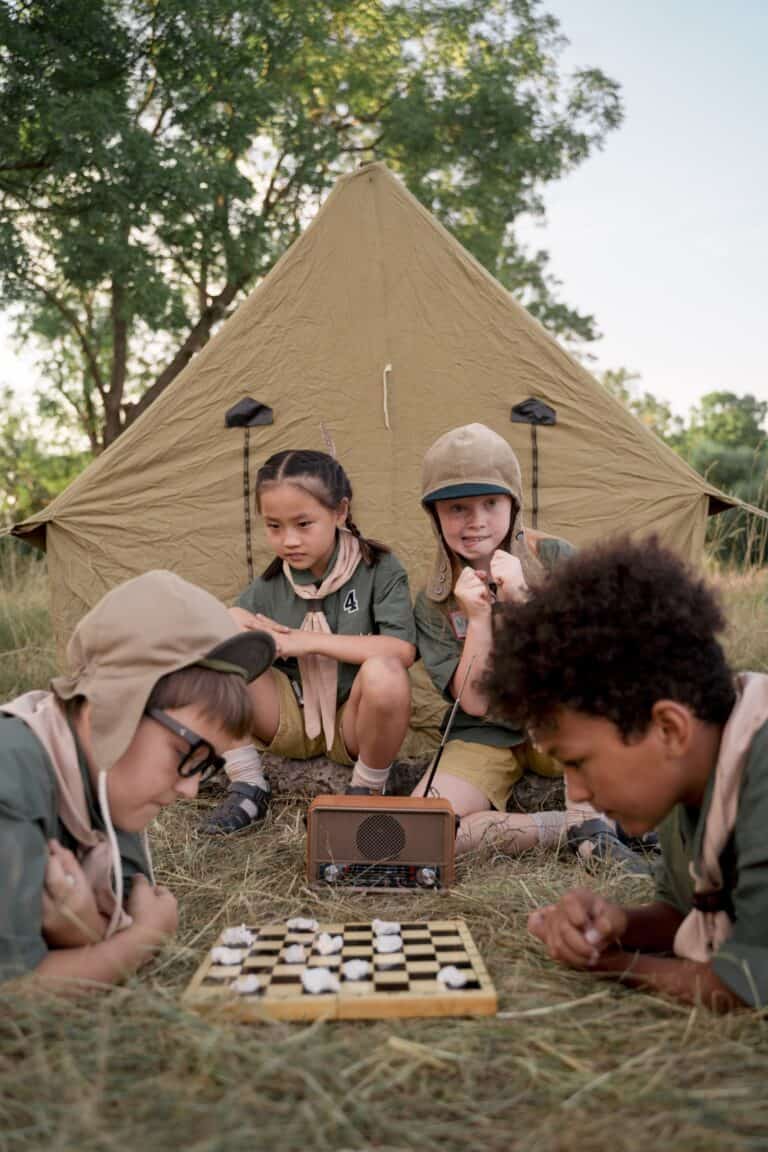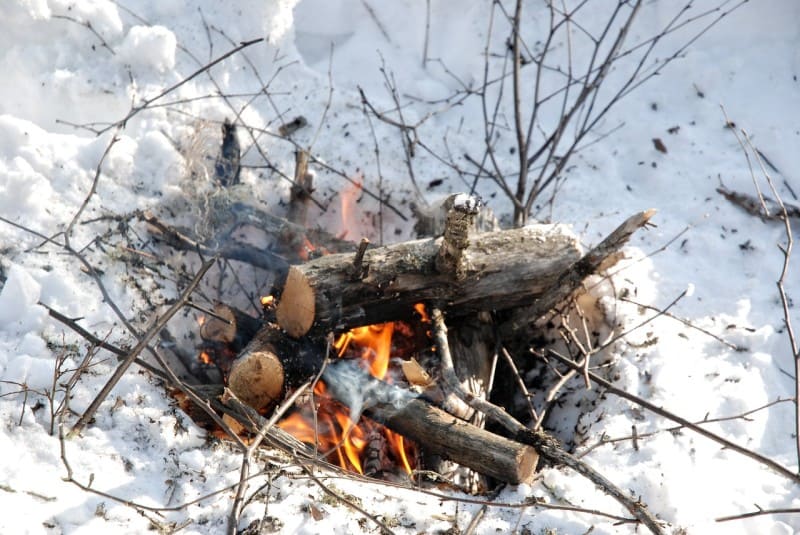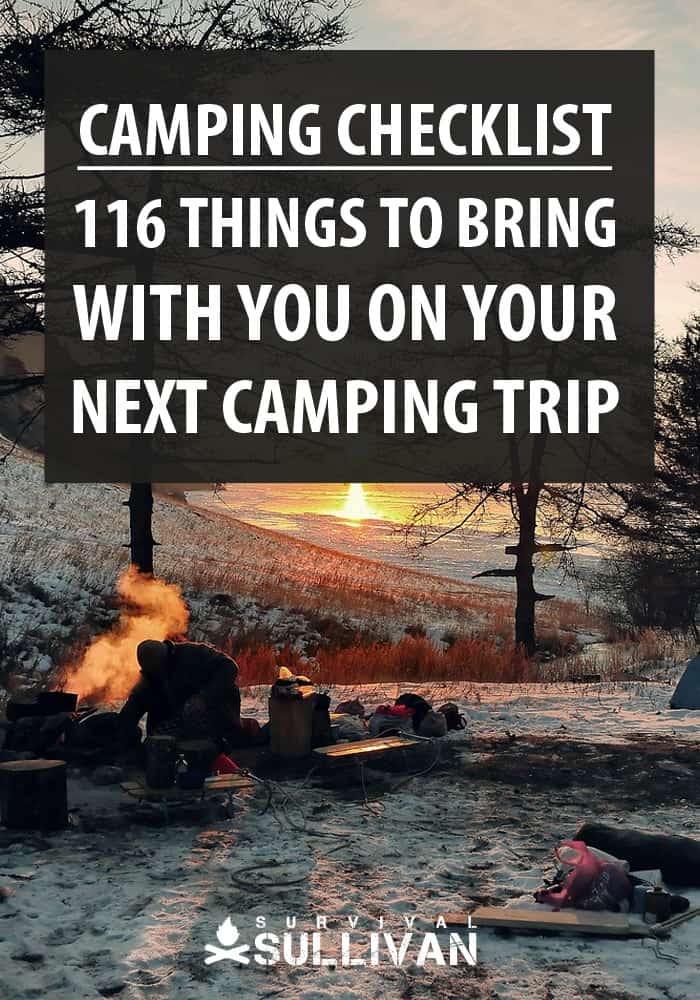Camping is a great way to practice skills for a SHTF or bug out situation. When it comes to a SHTF or bug out situation, your chance of survival is dependent upon how well you can handle whatever might come up.
The more camping you do now, before a SHTF or bug out situation happens, the more you can perfect your skills.

Camping is also a great way to get family members, friends, and other loved ones used to living a life without everyday luxuries and conveniences. We’ve put together a list of things to bring with you on your next camping trip, broken down by type of camping, so you can make sure you don’t forget any necessities.
Disclosure: This post has links to 3rd party websites, so I may get a commission if you buy through those links. Survival Sullivan is a participant in the Amazon Services LLC Associates Program. As an Amazon Associate, I earn from qualifying purchases. See my full disclosure for more.
For Nearly All Types of Camping
- Tent and materials for shelter building (stakes, hammer, hammock, etc.)
- Multiple ways to start a fire including a reliable method of fire starting for wet weather
- First aid kit
- Solar power charger for cell phone or other method of communication
- Lighting such as flashlights, headlamps, lanterns, and signal flares
- Food
- Knives
- Rain gear
- Swimsuit
- Bug repellent
- Sunscreen
- Personal medications and hygiene items
- Oral hygiene products
- Pet care items
- Hammer or mallet
- Duct tape
- Multi-tool
- Saw, axe, and or hatchet
- Pot holders
- Can opener
- Bandanas
- Toilet paper
- Sunglasses and sun hat
- Lip balm
- Baby wipes
- Comb/brush
- Cell Phone
- Hunting or fishing licenses or permits
- Spices and condiments
- Extra Batteries
- Signal whistle
- Camera and accessories
- Books or reading material
- Candles
- Fishing/Hunting licenses
- Notepad and pen/pencil
- Safety pins
- Sewing kit
- Umbrella
- Scissors
- Watch
- Water filter
For Primitive Camping
This type of camping typically involves heading out to an area without amenities where you intend to bring in what you need or find and use what you need from materials available in nature.
It is the most advanced form of camping and requires knowledge in a variety of areas. There are even people who choose to live a subsistence lifestyle, which is basically primitive camping, on a part-time or full time basis. Some of the things you may want to take with you to enhance your comfort and ability to survive include:
- Several books on plant and tree identification to help identify resources in the area
- Comprehensive first aid/trauma kit in case of serious injuries
- Small hatchet or solid bushcraft knife
- Water and/or reliable water filter
- Hunting and fishing equipment
- Garbage bags or sleeping bag and pillows
- Lighting such as lanterns, flashlights, headlamps, etc
- Stainless steel cooking pot or container for boiling water
- Sturdy shoes
- Camp shovel or sanitation trowel
- Portable shower
For Campground Camping
If you’re camping at a campground, it’s typically done as a vacation or getaway. So unless you are practicing your primitive camping or survival skills, you’ll probably want to bring along a lot of different items to make the trip more comfortable such as:
- Solar powered lanterns/light bulbs, tiki torches, or landscape lighting for the campsite
- Camp chairs for seating
- Ingredients to make S’mores
- Cooking stove and fuel or grate for fire pit
- Cooking pans or Dutch oven
- Cooler
- Zip lock storage bags
- Garbage bags
- Ice
- Paper cups, plates, plasticware
- Metal or high heat resistant cooking utensils
- Towels, shampoo, etc.
- Water shoes or shower shoes
- Biodegradable dish soap, plastic bin, sponge, paper towels
- Cutting board
- Camp table
- Clothesline and clothespins
- Bottle opener/corkscrew
- Charcoal
- Aluminum foil
- Portable coffee maker or metal percolator
- Vegetable Peeler
For Hiking or Backpack Camping
The key when hiking or backpack camping is portability. You need to be able to carry everything with you as move along the trail. Whether you are on a day hike or an extended backpack trip, you may need to bring some of these items for your next camping trip:
- Sturdy backpack that fits comfortably
- Map of the area, highlighting fresh water sources
- Reliable compass
- Paracord
- Binoculars
- Dry bags
- Hiking shoes/boots
- Quick drying pants
- Backpacking canister stove
- Canteen and/or pocket water filter
- Lightweight tent or bivvy bag

For Cold Weather/Winter Camping
Anyone who wishes to try cold weather or winter camping must ensure they are prepared to protect themselves from the elements and from nature’s predators. Exposure can bring on serious illness, cause permanent damage, or be fatal if you aren’t thoroughly prepared.
Weather can change quickly and without much warning which means you need to be prepared for anything. We’ve included a list of things to bring with you on your next camping trip for those who choose to brave the elements.
- Snow shoes
- Snow sled
- Insulated parka with hood
- Appropriate warm weather accessories (gloves, wool socks, stocking hat, etc.)
- Waterproof/breathable outerwear
- Mukluk boots (dry snow) or Sorel boots (wet snow)
- Raingear
- Wool scarf or balaclava
- Long john undergarments
- Insulated sleeping pad
- Collapsible snow shovel
- White-gas stove and fuel
- Rubberized gloves for handling fuel
- Trekking poles
- Sunglasses
- Lip balm and sunscreen
- Ice axe and crampons
- Urine bottle
- Metal tray for fire platform
- Beacon and probe for avalanches
- Personal locator or other way of signaling
- Headlamp
- Spare batteries
- Four season tent
- Cold weather rated sleeping bag
- Whisk broom for removing snow from clothing or tent
- Waterproof gaiters
- Charcoal activated hand/foot warmers
It’s important to have not only knowledge and skills but the right gear and equipment to help make your trip easier and in some cases help you survive.
Share your favorite type of camping in the comments below. No matter what type of camping you choose to do, consider some of these things to bring with you on your next camping trip.


Born and raised in NE Ohio, with early memories that include grandpa teaching her to bait a hook and watching her mom, aunts, and grandmothers garden, sew, and can food, Megan is a true farm girl at heart.
For Megan, the 2003 blackout, the events of 911, and the increasing frequency of natural disasters like Hurricane Katrina, spurred a desire to be more prepared. Soon to be living off-grid, this mother of four and grandmother of ten is learning everything she can about preparedness, survival, and homesteading.

Nice article if that is your type of “camping.” I like backpacking and I get a chuckle when I think of backpacking with all those items, lol.
all that shit really
I know, I know…just about anybody will tell you the purpose of going camping in the first place is to “get away from it all”. And, as you lay out in your comprehensive, well-thought-out article, the kind of camping you intend dictates the appropriate level of minimalism. But for campground camping, where we’re often driving our vehicle/s and all our gear right up to our campsites, consider adding to your list the following items:
-One or more “Mr. Heater”-brand portable propane heaters with a thermal output appropriate to the size of your tent/s. We really appreciate having a heater, especially with the levels of cold weather we can now camp in (coldest observed temp so far: +14F). Depending on the heater model, a fuel supply in the form of 1-lb propane bottles — or larger tank/s — will be required. The “Little Buddy” is one of several Mr. Heater models that operate with one single 1-lb bottle at a time, and that’s good for about 4 hours of operation. That means waking up cold after 4+ hours to change out the Little Buddy’s propane bottle. We did that for a couple of years, and despite the inevitable, predictable sleep interruption, it’s a big improvement over not having a heater. But when we acquired a new, larger, taller tent, we added a Mr. Heater “Big Buddy” model to our gear, fueled either by two attached 1-lb bottles, or remotely-connected to larger-capacity propane tank that must be kept outside the tent. We situate the Big Buddy heater inside the tent and connect it to the 20-lb propane tank outside the tent by means of a 12′ hose w/ filter. (By the way, the design of our new tent incorporates a separate, small Velcro’d opening near ground level to accommodate just such a layout…perfect.) The longest stay during which we’ve run the Big Buddy heater from the 20-lb tank — with considerable fuel remaining in the tank — was five nights…five, glorious nights of uninterrupted sleep. Nice.
-An inexpensive, lightweight folding cot (e.g., Coleman). If you intend to sleep in the cot inside a tent, be sure to confirm first that a cot will fit in your tent. About a year ago my wife and I accepted the reality that we have willingly slept on the ground just about enough for this lifetime; so along with a larger tent we acquired 30″ wide cots for each of us. Heaven. At our advancing ages, what a difference a really good night’s sleep makes in how we feel throughout our stay.
-Portable gasoline-powered generator, minimum 2200w “inverter-style” model (e.g., from Predator, Yamaha, Honda, B&S, etc.) “Why?” you ask. Because not only will it provide the electricity you need to power/ recharge your electronics, but also it’s sufficient to power the next very useful item (REMINDER: ALWAYS RESPECT YOUR FELLOW CAMPERS BY ADHERING STRICTLY TO ANY POSTED “GENERATOR HOURS”!):
-Small microwave oven (I hear your howls and scoffs and snorts of derision!!!) Truth is, we like — and plan — to enjoy delicious hot meals while campground camping, and the microwave helps us achieve that goal all year long. Especially because of the shorter daylight hours during fall and winter (9hrs 15min around here at the winter solstice), we want to spend that time recreating rather than cooking. Using our microwave to cook/heat food frees up an hour or two of precious daylight over the course of the day.
-Four 5-gallon plastic buckets, primarily to be used for washing dishes: #1 with pre-soak clear water; #2 with soapy water for dishwashing; #3 with clear water for first rinse; #4 with clear water for final rinse. The empty buckets stack for transport and can carry other objects, and they can be put to other uses.
That’s it. Thanks for writing and publishing your article.
Thanks for annoying everyone who likes to hear and smell nature with you generator.